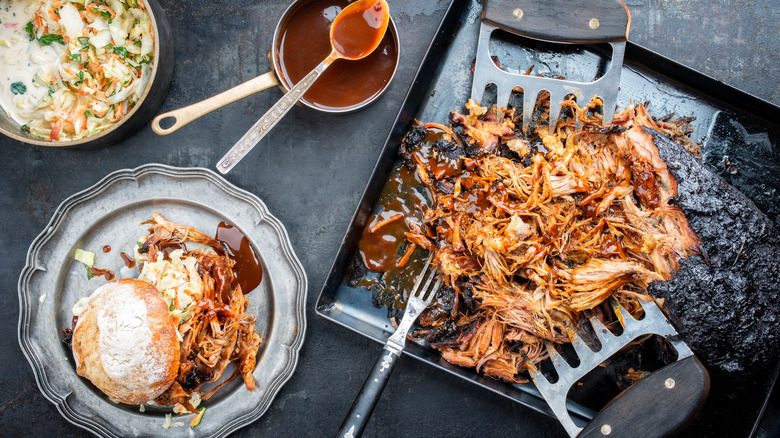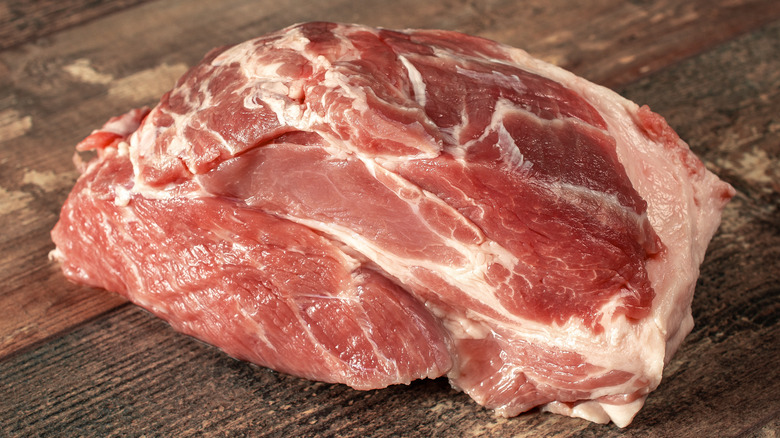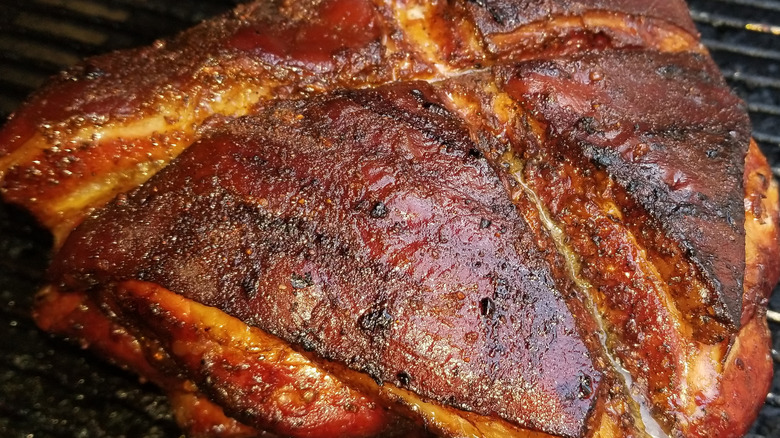Pork Shoulder Vs Pork Butt — Which Is Better For Homemade Barbecue?
For those curious about making delicious barbecue at home, it is easy to get lost in the sauce, so to speak. Before you even start pondering the wood, type of smoker, seasoning, cooking time, and so on, you have to start with the meat. Pork shoulder and pork butt are two common cuts used for making burnt ends or fall-apart tender pulled pork in various styles of American barbecue.
Though similar, one edges out the other as the superior choice for at-home barbecuers, according to Robbie Shoults, celebrity chef and third-generation owner of Bear Creek Smokehouse in Marshall, Texas. "I would certainly recommend pork butts for home cooks as it has more fat and marbling, which makes it a more forgiving cut of meat during the BBQ process," Shoults tells Food Republic.
Marbling refers to the specks or streaks of fat that run through the muscle, not the thick layers separating segments or the firmer fat cap. Fat creates a flavor difference between pork shoulder and pork butt, but marbling is particularly important when it comes to texture. As a piece of meat with ample marbling cooks, those filaments of fat melt, introducing moisture from the inside out. "Pork butts will not be as likely to dry out during the smoking process and will yield a juicier, more tender cut of meat," he explains. It requires anywhere from 6-18 hours of cooking time depending on the size, so you need that rendered fat to essentially continuously baste the meat.
Where are pork shoulder and pork butt located on a pig?
The shoulder and butt are somewhat similar in texture because they both "come from the same basic area of the pig and, a lot of times, the two terms are used interchangeably," Shoults tells Food Republic. "Pork butt has never been even close to the rear end of a hog like the name would imply," he explains. The name actually comes from the barrels — known as butts — that were used to store economical cuts of meat during the colonial era in New England.
Both sections are cut from the same larger primal cut that is then split in two subprimal cuts. The shoulder is the piece directly above the front leg (or hock), and the butt is the muscle section above that — it is located closer to the back and behind the head. The cuts tend to be on the tougher side, so they both benefit for a low-and-slow cook, but the shoulder is leaner because it sees more physical movement when the animal is alive. Since the butt is not used quite as much, it develops more fat.
How to buy pork shoulder and pork butt
The butt — often called a Boston butt — can be purchased with or without the bone and is usually skinless. When possible, opt for bone-in since it provides extra assurance that the meat will not dry out as it cooks. The fresher the meat, the better — it should be deeply pink, and the fat should be bright white. As you peer into the butcher case, look for as much marbling as possible.
The shoulder is also known as a picnic shoulder or picnic roast. It is usually bone-in and is often sold with part of the hock attached. When cut away from the bone, the shoulder is thinner, triangular, and more irregular in shape than a butt. The same visual cues that indicate a high-quality pork butt apply here too. Though this cut is tougher and less fatty than the butt, making it less preferable when you want something like pulled pork, it is desirable when you want crispy skin. The shoulder most often comes with the skin on, which is necessary when you want that crunchy outer layer, like for a Puerto Rican-style pernil.



